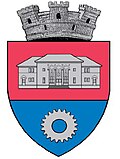Titu
| Titu | ||||
|
||||
| Basic data | ||||
|---|---|---|---|---|
| State : |
|
|||
| Historical region : | Great Wallachia | |||
| Circle : | Dâmbovița | |||
| Coordinates : | 44 ° 39 ' N , 25 ° 32' E | |||
| Time zone : | EET ( UTC +2) | |||
| Height : | 160 m | |||
| Area : | 42.51 km² | |||
| Residents : | 9,658 (October 20, 2011) | |||
| Population density : | 227 inhabitants per km² | |||
| Postal code : | 135500 | |||
| Telephone code : | (+40) 02 45 | |||
| License plate : | DB | |||
| Structure and administration (as of 2016) | ||||
| Community type : | city | |||
| Structure : | 5 districts / cadastral communities: Fusea , Hagioaica , Mereni , Plopu , Sălcuța | |||
| Mayor : | Traian Niculae ( PNL ) | |||
| Postal address : | Str. Nicolae Grigorescu, no. 1 loc. Titu, jud. Dâmbovița, RO-135500 |
|||
| Website : | ||||
Titu is a town in Dâmbovița County in Great Wallachia in Romania .
location
Titu is located in a part of the Wallachian Plain named after the city ( Câmpia Titu ) , about 10 kilometers west of the Dâmbovița river . The district capital Târgovişte is about 35 km north.
history
Titu was first mentioned in 1635, the now incorporated district of Plopu as early as 1536. In 1832 Titu was given the right to hold weekly markets (on Sundays) and a fair (September 14th). In 1876 two schools are mentioned, in 1902 a bank opened. In the years 1872-1884 the railway lines in connection with the construction arose Bucharest - Pitesti and Titu-Târgovişte around the station - the then bore the name Atîrnaţi - a new settlement that in 1927 a separate municipality under the name Principele Mihai (after Crown Prince or King Michael I ) became. After his forced abdication at the end of 1947, this community was named Mareșal Tito for a few months before the Yugoslav Prime Minister Josip Broz Tito , who was honored with it, fell out of favor in the socialist camp and thus also in Romania. Thereafter, the new settlement was called Titu Gară (roughly "Titu Station") and became the center of a new community consisting of seven villages. To distinguish the old village Titu was now called Titu Târg (about "Titu market"). Titu Gară and Titu Târg are now combined again to form Titu. In 1968 Titu received city rights.
On December 22, 1989 - during the revolution - the helicopter landed in Titu with the Ceaușescu couple , before they fled from here in a car and were finally arrested in Târgoviște.
The most important economic sectors are agriculture, the food, textile and electrical industries. In September 2010, Renault opened a large test center in Titu.
population
In 1831 there were 109 families in Titu Târg. In 1930, around 7,000 people lived in the area that is now the city. In the 2002 census, 10,183 people lived in Titu, including 10,024 Romanians and 154 Roma .
traffic
Titu is on the national road ( drum național ) DN 7 about ten kilometers (as the crow flies) northeast of the Romanian A1 motorway and on the railway line from Bucharest to Pitesti. There are direct connections to both cities several times a day. The branch to Târgovişte makes Titu an important railway junction in the south of the country.
Attractions
The small town of Titu has no particular tourist attractions.
In the incorporated villages of Sălcuța ( Cornetu ) the wooden church Sf. Nicolae , built in the 18th century, renovated at the end of the 19th century, and the Adormirea Maicii Domnului Church in Plopu , built in 1836, are listed buildings.
Web links
Individual evidence
- ↑ 2011 census in Romania at citypopulation.de
- ^ City website, accessed October 9, 2012
- ↑ Thomas Kunze : Nicolae Ceaușescu. A biography. 3rd, updated edition. Ch.links, Berlin 2009, ISBN 978-3-86153-562-1 , p. 387.
- ↑ punkto.ro of September 15, 2010, accessed on September 16, 2010
- ^ City website, accessed October 9, 2012
- ↑ 2002 census, accessed January 23, 2009
- ↑ Web presentation of the wooden church in Sălcuța at lacasedecult.cimec.ro, accessed on October 9, 2012
- ↑ List of historical monuments of the Romanian Ministry of Culture, updated 2010 (PDF; 7.10 MB)

